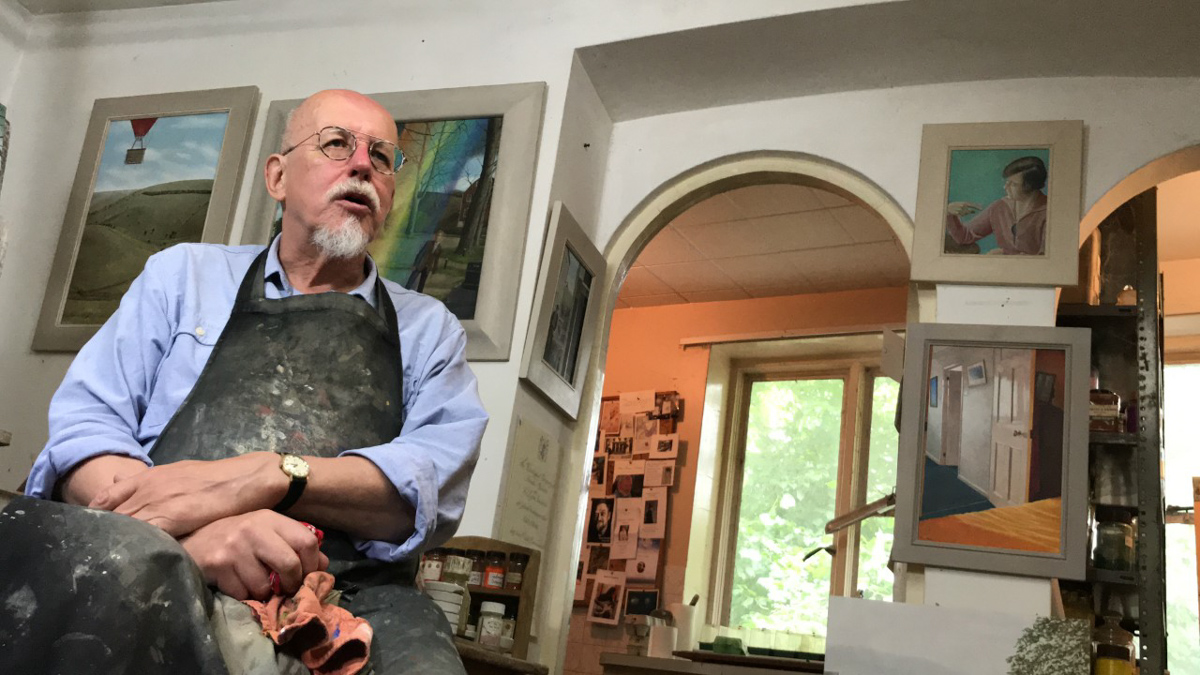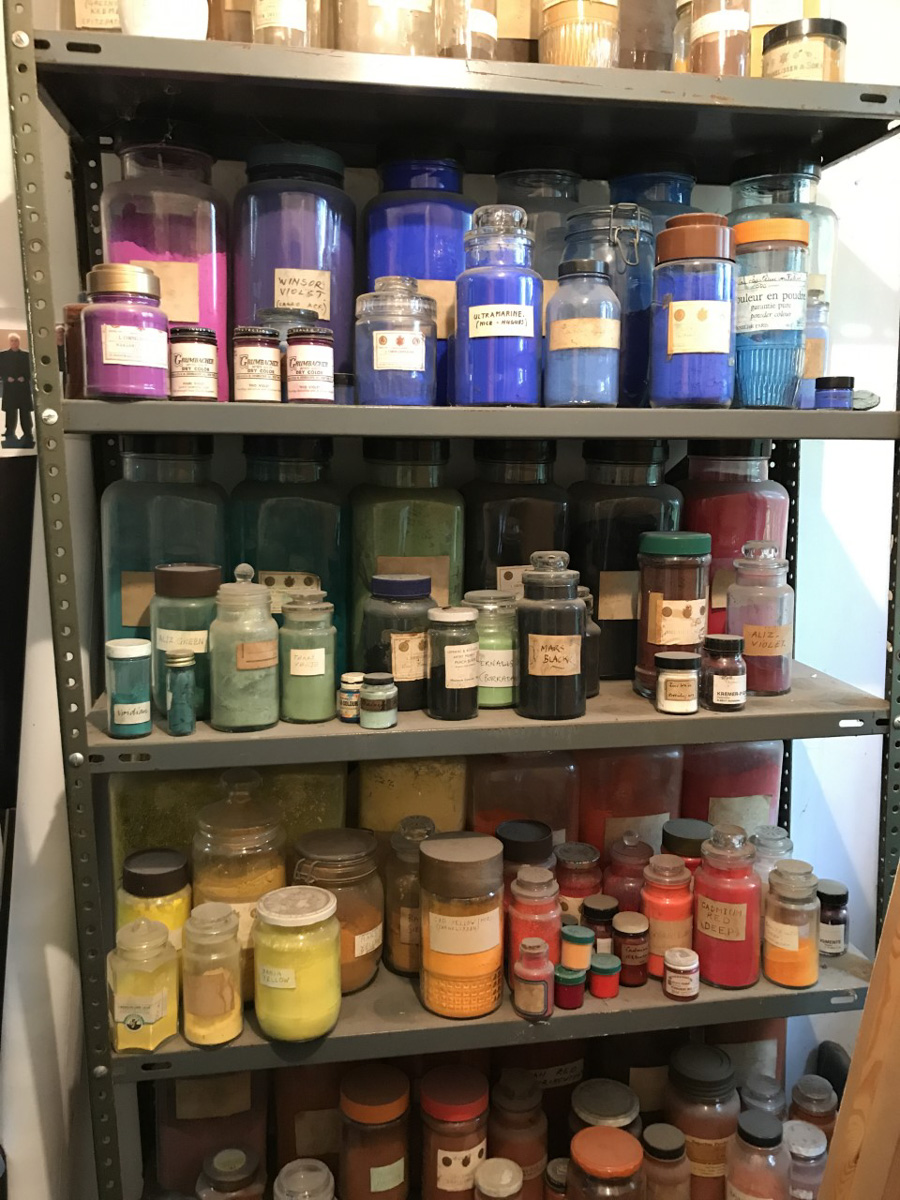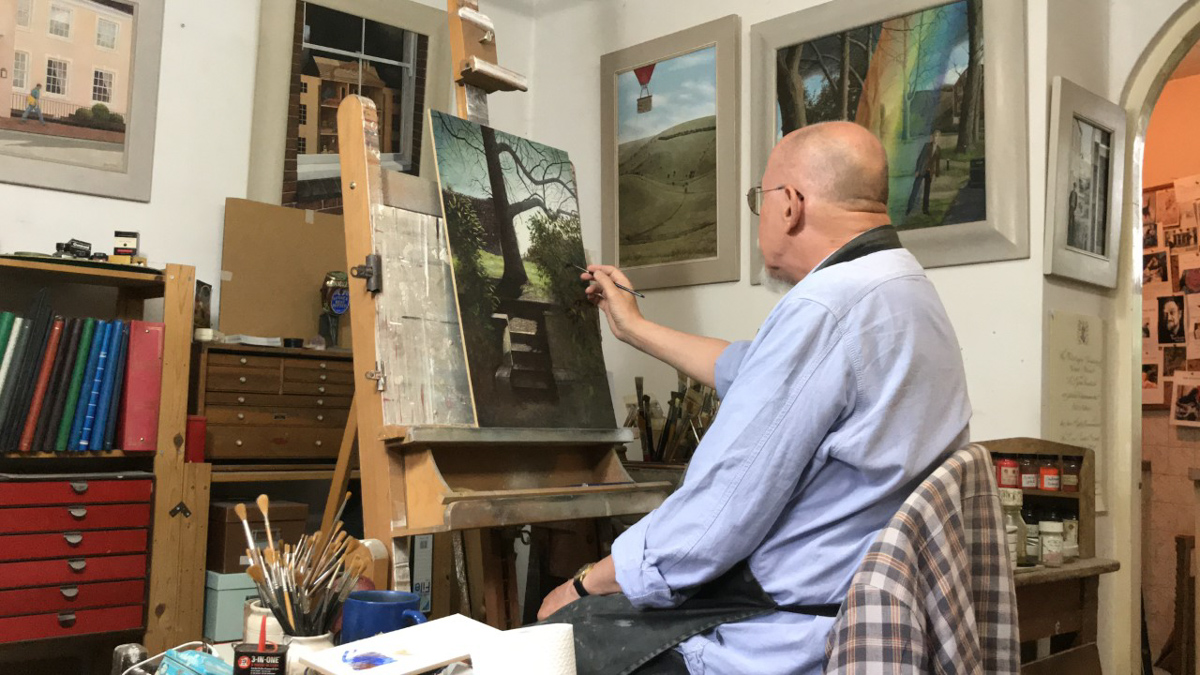messer paints tempera narratives

LEWES, England — Peter messer can be seen most days walking around Lewes, England. It is more than just for his health. The medieval town is the inspiration for his paintings.
His tempera paintings depict the town as dreamy and magical. “Cat’s Eyes” stars a tiny black cat on an evening stroll, its eyes lit up by the moon. The “Moon and the Star” shows a cloudy night on a lighted street corner. “The Moon was but a Chin of Gold” shows a road and dark sky, punctuated by a dainty crescent moon.
One might expect messer to be some mysterious wizard hiding secrets of an unseen dimension in his work, but in reality, he is a perfectly friendly man with what he describes as an overactive imagination.
He walks between home and his studio, between his studio and the Lewes Arms pub — one of his favorite haunts — and from the pub to the studio. He knows the town well. He points to a small piece of overgrown curb.
“It is kind of weird — I’ve done so many paintings just dealing with this piece of ground,” he said. “I don’t know, I just think it’s quite a powerful little space. I find myself drawn back to it all the time.”
messer turns onto Paddock Road, taking the same path as the little black cat from his painting. There is the same curve of the road, the same old wall, the same house.
“This wall was probably built about the 1780s, and it would be a new wall,” he said. “There would have been an older wall here before that.”
As messer walks, he tells not only the history of the town, but his own history as well. Behind the 300-year-old new wall is the plot where he used to grow vegetables. He stopped gardening after the death of his wife, Margaret, but he can see the cabin of the new gardeners from the road.
We approached the blue door to his studio where he has worked for 15 years. The building is decorated in squares of napped flint.
“The building dates back to 1820,” messer said. “It used to be stables for stagecoaches.”
He unlocks the door and climbs the entry stairs. At the top is a bookshelf filled with glass jars of colorful powders. These pigments are the start of his tempera paintings.

“This is like something out of ‘Harry Potter,’” he said. “I got so much of the stuff because I inherited it from a lovely old painter who died a few good years ago — 15 or 20 years ago — James Eddy. He was a tempera painter, same as me.”
messer said the collection of pigments has grown.
“Not many people use this as medium, so I ended up with a lot of it,” he said. “I will never live long enough to use this.”
The scene on his easel is the curb we passed on our way to the studio — the one he says he keeps drawing.
“I don’t know quite what I’m going to do with it yet,” he said. “As you can see, there’s still a lot of work to be done.”
The studio is full of paintings. They are hung all over the place, leaning against walls a couple layers deep, and laying face up on tabletops.
messer said he doesn’t really look at the completed paintings around him, they are in storage until they can be moved on.
“The thing that really interests you is the one you’re doing,” he said.
messer’s work begins in the kitchenette. He takes an egg from the refrigerator.
“(Tempera) is just royal pigment mixed with egg yolk,” he said.
messer pulls a container from the cupboard.
“This is my egg jar,” he said. “The latest in a long line of egg jars, because they usually get broken somewhere along the way.”
messer cracks an egg on the counter top and breaks it into his hand.
“You just use the yolk,” he said, balancing the egg between his fingers and running it under tap water. “You don’t want the white on it.”
He handles the delicate yolk the way he has been practicing for years. He dries the yolk on a square of toilet paper.
“I don’t think the Florentines had toilet paper,” he said referencing the history of his medium, “But they would have really gone for it.”
He folds the paper in half and pops the yolk so it runs into the jar. messer adds water to thin the consistency, and stirs it together in the jar.
messer selects a vibrant ultramarine blue pigment to make into paint.
“Real ultramarine blue is made out of a semi-precious stone called lapis lazuli,” he said. “It was ground down in medieval times and cost an absolute fortune. In the Victorian times, they found a way to synthesize it chemically and make an affordable version of it.”
He scoops a tiny amount into a saucer and mixes it with equal parts water. messer said the measurements aren’t strict — he can tell when it’s working and when it’s not.
messer adds a small amount of egg yolk to the mixture. The yolk contains natural oils and a chemical, lecithin, which enables the eggs to form an emulsion.
“What you get is an oil that is soluble in water,” he said. “This is old technology — people were not fools in the 15th century.”
The yellow color from the yolk disappears when mixed into the pigment and won’t appear on the painting.
“It has to have a loose consistency because you build it up in thin layers,” he said, mixing the paint in a little saucer.
messer selects another vial from his desk.
“Different pigments are made from different materials — that’s a real interest in itself,” he said. “This is burnt sienna. It’s roasted native earth. It’s called ‘sienna’ because that’s the part of Italy where it was originally sourced, but you can find the same thing in different parts of the world.”
Tempera paints are applied to a hard surface. messer makes gesso panel from powdered chalk and leather waste glue on fiberboard in large batches because it’s more affordable.

He said part of the reason he chose to work with tempera was the rich history of the art.
“If Raphael walked into the studio, he’d look around and see stuff he could work with because it’s the same stuff,” messer said. “It’s an unbroken link with how people used to work.
“It’s timeless. It exists out of time because it’s not part of any modern thing and it’s not part of an older thing — I’m using it in a way those old Florentine painters would have never thought to do.”
messer said he likes his paintings to have a narrative.
“It’s half literary, half visual, really — a poetic undertone to the thing,” he said.
In one painting, a walker strolls down a path, oblivious to an arm that reaches out to him from a tree. Instead of explaining the poetic undertone of the image, messer shrugs.
Finding inspiration is not as dramatic as one might think, messer said.
“Sometimes I think of a title or a piece of writing or poetry or phrase,” he said. “It doesn’t always come just visually, it comes by various means. I keep notebooks of things, and I almost write more than I sketch because that will take me back to an atmosphere quicker than a picture I’ve scribbled down.”
messer said he’s sold a few hundred paintings over his long career. He paints Lewes often because that’s where he is, and he said he has a lot of love for the town and people in it.
Lewes’ location, near Brighton and an hour from London, surrounded by universities, leads to a rich community of academics, artists and musicians, messer said.
“It’s one of those weird little places where things happen,” he said. “It reminds me of an Emily Dickinson poem, ‘I went to heaven, ’twas a small town.’”
Later that evening, in another charming pub called the Gardener’s Arms, messer mentions the painting of the arm reaching down from a tree. He said it was like the feeling of something reaching out to you as you walk by.
In Lewes, perhaps he feels the past reaching out to him as he walks by.
Or perhaps it is through his paintings that he walks the viewer through narratives of the town, his art, and his life.
